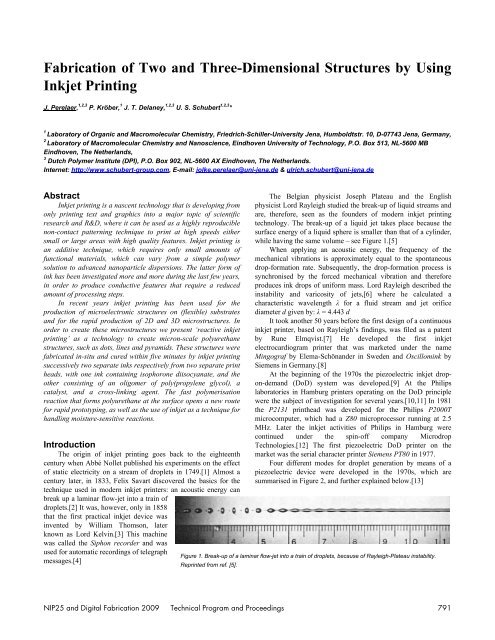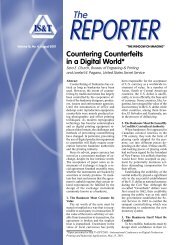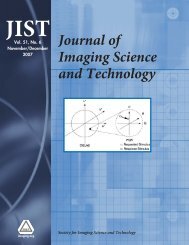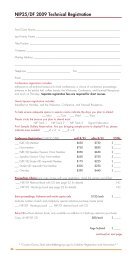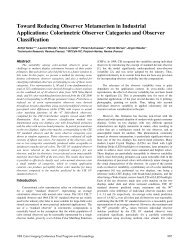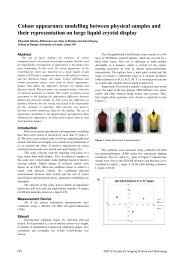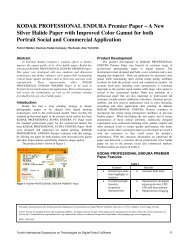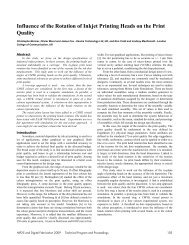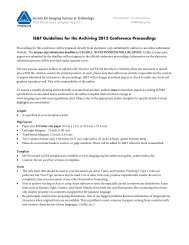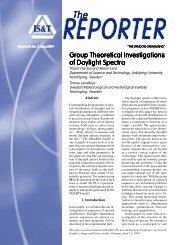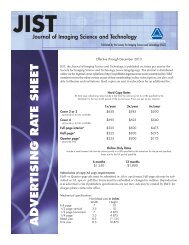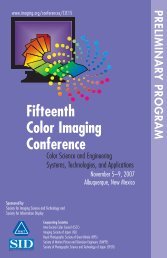Fabrication of Two and Three-Dimensional Structures by Using ...
Fabrication of Two and Three-Dimensional Structures by Using ...
Fabrication of Two and Three-Dimensional Structures by Using ...
You also want an ePaper? Increase the reach of your titles
YUMPU automatically turns print PDFs into web optimized ePapers that Google loves.
<strong>Fabrication</strong> <strong>of</strong> <strong>Two</strong> <strong>and</strong> <strong>Three</strong>-<strong>Dimensional</strong> <strong>Structures</strong> <strong>by</strong> <strong>Using</strong><br />
Inkjet Printing<br />
J. Perelaer, 1,2,3 P. Kröber, 1 J. T. Delaney, 1,2,3 U. S. Schubert 1,2,3 *<br />
1<br />
Laboratory <strong>of</strong> Organic <strong>and</strong> Macromolecular Chemistry, Friedrich-Schiller-University Jena, Humboldtstr. 10, D-07743 Jena, Germany,<br />
2<br />
Laboratory <strong>of</strong> Macromolecular Chemistry <strong>and</strong> Nanoscience, Eindhoven University <strong>of</strong> Technology, P.O. Box 513, NL-5600 MB<br />
Eindhoven, The Netherl<strong>and</strong>s,<br />
3<br />
Dutch Polymer Institute (DPI), P.O. Box 902, NL-5600 AX Eindhoven, The Netherl<strong>and</strong>s.<br />
Internet: http://www.schubert-group.com, E-mail: jolke.perelaer@uni-jena.de & ulrich.schubert@uni-jena.de<br />
Abstract<br />
Inkjet printing is a nascent technology that is developing from<br />
only printing text <strong>and</strong> graphics into a major topic <strong>of</strong> scientific<br />
research <strong>and</strong> R&D, where it can be used as a highly reproducible<br />
non-contact patterning technique to print at high speeds either<br />
small or large areas with high quality features. Inkjet printing is<br />
an additive technique, which requires only small amounts <strong>of</strong><br />
functional materials, which can vary from a simple polymer<br />
solution to advanced nanoparticle dispersions. The latter form <strong>of</strong><br />
ink has been investigated more <strong>and</strong> more during the last few years,<br />
in order to produce conductive features that require a reduced<br />
amount <strong>of</strong> processing steps.<br />
In recent years inkjet printing has been used for the<br />
production <strong>of</strong> microelectronic structures on (flexible) substrates<br />
<strong>and</strong> for the rapid production <strong>of</strong> 2D <strong>and</strong> 3D microstructures. In<br />
order to create these microstructures we present ‘reactive inkjet<br />
printing’ as a technology to create micron-scale polyurethane<br />
structures, such as dots, lines <strong>and</strong> pyramids. These structures were<br />
fabricated in-situ <strong>and</strong> cured within five minutes <strong>by</strong> inkjet printing<br />
successively two separate inks respectively from two separate print<br />
heads, with one ink containing isophorone diisocyanate, <strong>and</strong> the<br />
other consisting <strong>of</strong> an oligomer <strong>of</strong> poly(propylene glycol), a<br />
catalyst, <strong>and</strong> a cross-linking agent. The fast polymerisation<br />
reaction that forms polyurethane at the surface opens a new route<br />
for rapid prototyping, as well as the use <strong>of</strong> inkjet as a technique for<br />
h<strong>and</strong>ling moisture-sensitive reactions.<br />
Introduction<br />
The origin <strong>of</strong> inkjet printing goes back to the eighteenth<br />
century when Abbé Nollet published his experiments on the effect<br />
<strong>of</strong> static electricity on a stream <strong>of</strong> droplets in 1749.[1] Almost a<br />
century later, in 1833, Felix Savart discovered the basics for the<br />
technique used in modern inkjet printers: an acoustic energy can<br />
break up a laminar flow-jet into a train <strong>of</strong><br />
droplets.[2] It was, however, only in 1858<br />
that the first practical inkjet device was<br />
invented <strong>by</strong> William Thomson, later<br />
known as Lord Kelvin.[3] This machine<br />
was called the Siphon recorder <strong>and</strong> was<br />
used for automatic recordings <strong>of</strong> telegraph<br />
messages.[4]<br />
Reprinted from ref. [5].<br />
The Belgian physicist Joseph Plateau <strong>and</strong> the English<br />
physicist Lord Rayleigh studied the break-up <strong>of</strong> liquid streams <strong>and</strong><br />
are, therefore, seen as the founders <strong>of</strong> modern inkjet printing<br />
technology. The break-up <strong>of</strong> a liquid jet takes place because the<br />
surface energy <strong>of</strong> a liquid sphere is smaller than that <strong>of</strong> a cylinder,<br />
while having the same volume – see Figure 1.[5]<br />
When applying an acoustic energy, the frequency <strong>of</strong> the<br />
mechanical vibrations is approximately equal to the spontaneous<br />
drop-formation rate. Subsequently, the drop-formation process is<br />
synchronised <strong>by</strong> the forced mechanical vibration <strong>and</strong> therefore<br />
produces ink drops <strong>of</strong> uniform mass. Lord Rayleigh described the<br />
instability <strong>and</strong> varicosity <strong>of</strong> jets,[6] where he calculated a<br />
characteristic wavelength λ for a fluid stream <strong>and</strong> jet orifice<br />
diameter d given <strong>by</strong>: λ = 4.443 d<br />
It took another 50 years before the first design <strong>of</strong> a continuous<br />
inkjet printer, based on Rayleigh’s findings, was filed as a patent<br />
<strong>by</strong> Rune Elmqvist.[7] He developed the first inkjet<br />
electrocardiogram printer that was marketed under the name<br />
Mingograf <strong>by</strong> Elema-Schön<strong>and</strong>er in Sweden <strong>and</strong> Oscillomink <strong>by</strong><br />
Siemens in Germany.[8]<br />
At the beginning <strong>of</strong> the 1970s the piezoelectric inkjet dropon-dem<strong>and</strong><br />
(DoD) system was developed.[9] At the Philips<br />
laboratories in Hamburg printers operating on the DoD principle<br />
were the subject <strong>of</strong> investigation for several years.[10,11] In 1981<br />
the P2131 printhead was developed for the Philips P2000T<br />
microcomputer, which had a Z80 microprocessor running at 2.5<br />
MHz. Later the inkjet activities <strong>of</strong> Philips in Hamburg were<br />
continued under the spin-<strong>of</strong>f company Microdrop<br />
Technologies.[12] The first piezoelectric DoD printer on the<br />
market was the serial character printer Siemens PT80 in 1977.<br />
Four different modes for droplet generation <strong>by</strong> means <strong>of</strong> a<br />
piezoelectric device were developed in the 1970s, which are<br />
summarised in Figure 2, <strong>and</strong> further explained below.[13]<br />
Figure 1. Break-up <strong>of</strong> a laminar flow-jet into a train <strong>of</strong> droplets, because <strong>of</strong> Rayleigh-Plateau instability.<br />
NIP25 <strong>and</strong> Digital <strong>Fabrication</strong> 2009 Technical Program <strong>and</strong> Proceedings 791
(a) Squeeze mode<br />
(b) Bend mode<br />
(c) Push mode<br />
Figure 2. Different piezoelectric drop-on-dem<strong>and</strong> technologies. Reprinted from ref. [13].<br />
Firstly, the squeeze method, invented <strong>by</strong> Steven Zoltan,[14]<br />
uses a hollow tube <strong>of</strong> piezoelectric material, that squeezes the ink<br />
chamber upon an applied voltage (Figure 2a). The squeeze method<br />
is nowadays also used in Microdrop printing devices.[12]<br />
Secondly, the bend-mode (Figure 2b) uses the bending <strong>of</strong> a wall <strong>of</strong><br />
the ink chamber as method for droplet ejection <strong>and</strong> was discovered<br />
simultaneously <strong>by</strong> Stemme[15] <strong>of</strong> the Chalmers University in<br />
Sweden <strong>and</strong> Kyser et al. <strong>of</strong> the Silonics company in the USA.[16]<br />
This technique is used for example in Tektronix <strong>and</strong> Epson<br />
printers. The third mode is the pushing method <strong>by</strong> Howkins<br />
(Figure 2c),[17] where a piezoelectric element pushes against an<br />
ink chamber wall to expel droplets, <strong>and</strong> is nowadays used in<br />
Trident, Brother <strong>and</strong> Epson printers. Finally, Fishbeck et al.<br />
proposed the shear-mode (Figure 2d),[18] where the electric field<br />
is designed to be perpendicular to the polarization <strong>of</strong> the piezoceramics.<br />
Typical pioneers in shear mode printheads are Xaar <strong>and</strong><br />
Spectra.[13]<br />
Although inkjet printing <strong>of</strong>fers a simple <strong>and</strong> direct method <strong>of</strong><br />
electronic controlled writing with many advantages, including high<br />
speed production, silent, non-impact <strong>and</strong> fully electronic operation,<br />
inkjet printers failed to be commercially successful in their<br />
beginning: print quality as well as reliability <strong>and</strong> costs were hard to<br />
combine in a single printing technique. Thermal inkjet changed the<br />
image <strong>of</strong> inkjet printing dramatically. Not only could thermal<br />
transducers be manufactured in much smaller sizes, since they<br />
require a simple resistor instead <strong>of</strong> a piezoelectric element, but also<br />
at lower costs. Therefore, thermal inkjet printers dominate the<br />
colour printing market nowadays.[19]<br />
In scientific research piezoelectric DoD inkjet systems are<br />
mainly used because <strong>of</strong> their ability to dispense a wide variety <strong>of</strong><br />
solvents, whereas thermal DoD printers are more compatible with<br />
aqueous solutions.[20] Furthermore, the rapid <strong>and</strong> localised<br />
heating <strong>of</strong> the ink within thermal inkjets induces thermal stress on<br />
the ink.<br />
(d) Shear mode<br />
Although inkjet printers are<br />
widely used for graphical<br />
applications, it was only within the<br />
last decades that inkjet printing has<br />
grown to a mature patterning<br />
technique. As a consequence, it<br />
has gained specific attention in<br />
scientific research because <strong>of</strong> its<br />
high precision <strong>and</strong> its additive<br />
nature: only the necessary amount<br />
<strong>of</strong> functional material is dispensed.[21] Furthermore, the absence<br />
<strong>of</strong> physical contact between print head <strong>and</strong> substrate allows many<br />
potential applications, such as inkjet printing <strong>of</strong> labels onto rough<br />
curved surfaces, or surfaces that are sensitive to pressure. Inkjet<br />
printing is utilised to dose many different kinds <strong>of</strong> materials, such<br />
as conductive polymers <strong>and</strong> nanoparticles,[22-24] sol-gel<br />
materials,[25] cells,[26] structural polymers,[27] ceramics[28,29]<br />
<strong>and</strong> even molten metals.[30]<br />
The impact <strong>of</strong> a droplet has a significant influence on the final<br />
printed feature, but also <strong>of</strong> great concern is a frequently observed<br />
in-homogeneous drying effect <strong>of</strong> liquid droplets on a nonabsorbing<br />
substrate, the so-called “c<strong>of</strong>fee drop” effect;[31,32]<br />
solute present in the solution deposits near the boundary <strong>of</strong> inkjet<br />
printed droplets – this behaviour is similar to when drops <strong>of</strong> c<strong>of</strong>fee<br />
are spilt on the table. When using the technique <strong>of</strong> inkjet printing,<br />
for example for the application <strong>of</strong> OLEDs, this effect should be<br />
minimized for correct device functionality.[33] However, much<br />
research has been conducted to prevent the c<strong>of</strong>fee ring effect, for<br />
example <strong>by</strong> applying an increased substrate temperature, in order<br />
to stimulate solvent evaporation, which subsequently minimises<br />
line or film bleeding,[34,35] <strong>and</strong> <strong>by</strong> combining a high <strong>and</strong> low<br />
boiling solvent, which reduces the high evaporation rate at a liquid<br />
feature’s edge.[36]<br />
Inkjet printers have also been used in several studies in order<br />
to produce a series <strong>of</strong> equal-sized droplets, which allowed the<br />
reduction <strong>of</strong> errors in the measurements <strong>and</strong> significantly increased<br />
the experimental reproducibility.[37,38]<br />
The resolution <strong>of</strong> inkjet printed structures is comparable to the<br />
nozzle diameter, <strong>and</strong> is typically between 30 <strong>and</strong> 100 µm. While<br />
decreasing the nozzle diameter improves resolution, it also creates<br />
a smaller window <strong>of</strong> inks that can be used for printing, with respect<br />
to their viscosity <strong>and</strong> surface tension.[39]<br />
Finally, the printability <strong>of</strong> an ink can be formulated <strong>by</strong><br />
Fromm’s Z-number, which is the inverse <strong>of</strong> the Ohnesorge number<br />
PU-network<br />
OH<br />
HO<br />
O<br />
OH<br />
H<br />
n OH<br />
+<br />
NCO<br />
OCN<br />
cat.<br />
Poly(propylene-glycol) 3-Isophorondiisocyanate<br />
PU-network<br />
H<br />
N<br />
O<br />
O<br />
O<br />
O<br />
n<br />
O<br />
H<br />
N<br />
N<br />
H<br />
O<br />
O<br />
O<br />
HN<br />
O<br />
O<br />
O<br />
NH<br />
N<br />
H<br />
O<br />
O<br />
O<br />
n<br />
O<br />
O<br />
N<br />
H<br />
PU-network<br />
N<br />
H<br />
O<br />
O<br />
O<br />
n<br />
O<br />
O<br />
N<br />
H<br />
Cross-linked polyurethane<br />
Figure 3. Schematic representation <strong>of</strong> the reaction scheme for the formation <strong>of</strong> polyurethanes from the reactants.<br />
792 Society for Imaging Science <strong>and</strong> Technology
(Oh): Z = η -1 (ρDσ) 1/2 = Oh -1 , where ρ, σ <strong>and</strong> η are the inks density,<br />
surface tension <strong>and</strong> viscosity, respectively. D is a characteristic<br />
length, which in the case <strong>of</strong> inkjet printing is the nozzle diameter.<br />
Fromm predicted that drop formation in DoD systems was possible<br />
only when the Z-number is greater than 2.[40]<br />
Results <strong>and</strong> discussion<br />
Many different techniques exist in rapid prototyping for<br />
fabrication <strong>of</strong> solid structures. One <strong>of</strong> the main drawbacks <strong>of</strong> rapid<br />
prototyping technologies is that only a selected range <strong>of</strong> materials<br />
can be processed directly. Some materials, like bio-ceramics,<br />
biodegradable polymers, <strong>and</strong> silicones are accessible only <strong>by</strong> posttreatment<br />
processes like pre-molding <strong>of</strong> the samples.<br />
In order to achieve the multi-micron feature resolution<br />
typically associated with rapid prototyping techniques, inkjet<br />
printing was considered as a synthesis tool. This technique is also<br />
called reactive inkjet printing, <strong>and</strong> is a precise method for building<br />
up small structures using certain reactive materials, like<br />
polyurethanes.<br />
Towards this aim, the synthesis <strong>of</strong> polyurethane-based<br />
materials was seen as a particularly illustrative example. The<br />
chemistry <strong>of</strong> this involves the preparation <strong>of</strong> two separate inks, one<br />
containing a diol, <strong>and</strong> the second containing a diisocyanate. The<br />
two inks are printed as successive layers on a surface, <strong>and</strong> are<br />
allowed to react to form urethane bonds. <strong>Two</strong> separate inks were<br />
subsequently inkjet printed onto each other on the substrate,<br />
illustrated <strong>by</strong> the schematic representation in Figure 3.<br />
After printing, the reactants cured <strong>and</strong> hardened more quickly<br />
with the addition <strong>of</strong> the cross-linking agent trimethylolpropane <strong>and</strong><br />
a catalyst. To monitor the progress <strong>of</strong> the reaction in situ the<br />
polymerisation kinetics in crosslinked urethane films was <strong>by</strong> FTIR<br />
spectroscopy.[41] As the isocyanate <strong>and</strong> diol functional groups are<br />
consumed, the result is an attenuation <strong>of</strong> the isocyanate peak with a<br />
maximum around 2260 cm -1 . By using an unchanging reference<br />
peak (e.g. the alkane peak at 2960 cm -1 ), the degree <strong>of</strong> conversion<br />
can be calculated as a function <strong>of</strong> the change in the intensity <strong>of</strong> the<br />
isocyanate peak relative to the alkane peak at a particular time<br />
point, compared to the initial isocyanate/alkane peak height ratio,<br />
as depicted in Figure 4.<br />
Furthermore, the substrate holder was heated to 90 °C, which<br />
resulted in conversions between 60 <strong>and</strong> 70% for a catalyst<br />
concentration between 0.1 <strong>and</strong> 2.0 wt%. Due to this relatively high<br />
conversion, solid polyurethane structures were obtained after three<br />
minutes. The resulting structures were measured using optical<br />
pr<strong>of</strong>ilometry, as shown in Figure 5.<br />
Figure 5. Five inkjet printed lines <strong>of</strong> in-situ formed polyurethane. From top to<br />
bottom, the parallel lines consist <strong>of</strong> an increased number <strong>of</strong> layers, where<br />
each layer consists <strong>of</strong> two print runs from both reactants. From top to bottom<br />
the number <strong>of</strong> layer decreases from 5 to 1, respectively.<br />
Conclusions<br />
We have demonstrated that defined micron-scale<br />
polyurethane-based structures can be fabricated via reactive inkjet<br />
printing starting from the corresponding monomers in a reactive,<br />
in-situ manner on glass substrates. This approach yields unique,<br />
cross-linked thermoset PU materials with spatial resolution in the<br />
range <strong>of</strong> tens <strong>of</strong> microns.<br />
Acknowledgements<br />
The authors would like to thank Dr. Laszlo Majoros (Recticel)<br />
for fruitful discussions <strong>and</strong> the Dutch Polymer Institute for<br />
financial support.<br />
References<br />
Figure 4. In-situ reaction kinetics for the formation <strong>of</strong> polyurethane <strong>by</strong><br />
FTIR spectroscopy.<br />
1 J. A. Nollet, W. Watson, “Examination <strong>of</strong> Certain Phaenomena in<br />
Electricity”, Philos. Trans., 46, 368 (1749).<br />
2 F. Savart, “Mémoires sur la Constitution des Veines Liquides<br />
Lancées par des Orifices Circulaires en Mince Paroi”, Ann. Chim.<br />
Phys., 53, 337 (1833).<br />
3 W. Thomson, UK Patent 2,147 (1867).<br />
NIP25 <strong>and</strong> Digital <strong>Fabrication</strong> 2009 Technical Program <strong>and</strong> Proceedings 793
4 http://en.wikipedia.org/wiki/Lord_Kelvin (last accessed: 11 th June<br />
2009).<br />
5 E. F. Goedde, M. C. Yuen, “Experiments on Liquid Jet Instability”,<br />
J. Fluid Mech., 40, 495 (1970).<br />
6 Lord Rayleigh, “On the Instability <strong>of</strong> Jets”, Proc. London Math. Soc.,<br />
10, 4 (1878).<br />
7 R. Elmqvist, US Patent 2,566,443 (1951).<br />
8 F. J. Kamphoefner, “Inkjet Printing”, IEEE T. Electron. Dev., 19, 584<br />
(1972).<br />
9 R. D. Carnahan, S. L. Hou, “Ink jet Technology”, IEEE Trans. Ind.<br />
Appl., IA-13, 95 (1977).<br />
10 M. Döring, “Inkjet Printing”, Philips Tech. Rev., 40, 192 (1982).<br />
11 J. van R<strong>and</strong>eraat, R. E. Setterington, “Piezoelectric Ceramics, Philips<br />
Application-Book”, 2 nd Edition, Mullard Ltd., London (1974).<br />
12 http://www.microdrop.de (last accessed: 11 th June 2009).<br />
13 J. Brünahl, A. M. Grishin, “Piezoelectric Shear Mode Drop-On-<br />
Dem<strong>and</strong> Inkjet Actuator”, Sens. Actuators A, 101, 371 (2002).<br />
14 S. I. Zoltan, US Patent 3,683,212 (1972).<br />
15 N. G. E. Stemme, US Patent 3,747,120 (1972).<br />
16 E. L. Kyser, S. B. Sears, US Patent 3,946,398 (1976).<br />
17 S. D. Howkins, US Patent 4,459,601 (1984).<br />
18 K. H. Fishbeck, A. T. Wright, US Patent 4,584,590 (1986).<br />
19 H. Kipphan, “H<strong>and</strong>book <strong>of</strong> Print Media: Technologies <strong>and</strong><br />
Manufacturing Processes”, Springer (2001).<br />
20 B.-J. de Gans, P. C. Duineveld, U. S. Schubert, “Inkjet Printing <strong>of</strong><br />
Polymers: State <strong>of</strong> the Art <strong>and</strong> Future Developments”, Adv. Mater.,<br />
16, 203 (2004).<br />
21 E. Tekin, P. J. Smith, U. S. Schubert, “Inkjet Printing as a Deposition<br />
<strong>and</strong> Patterning Tool for Polymers <strong>and</strong> Inorganic Particles”, S<strong>of</strong>t<br />
Matter, 4, 703 (2008).<br />
22 P. Calvert, “Inkjet Printing for Materials <strong>and</strong> Devices”, Chem. Mater.,<br />
13, 3299 (2001).<br />
23 E. Tekin, H. Wijlaars, E. Holder, D. A. M. Egbe, U. S. Schubert,<br />
“Film Thickness Dependency <strong>of</strong> the Emission Colors <strong>of</strong> PPE-PPVs in<br />
Inkjet Printed Libraries”, J. Mater. Chem., 16, 4294 (2006).<br />
24 T. H. J. van Osch, J. Perelaer, A. W. M. de Laat, U. S. Schubert,<br />
“Inkjet Printing <strong>of</strong> Narrow Conductive Tracks on Untreated<br />
Polymeric Substrates”, Adv. Mater., 20, 343 (2008).<br />
25 A. M. J. van den Berg, A. W. M. de Laat, P. J. Smith, J. Perelaer, U.<br />
S. Schubert, “Geometric Control <strong>of</strong> Inkjet Printed Features <strong>Using</strong> a<br />
Gelating Polymer”, J. Mater. Chem., 17, 677 (2007).<br />
26 B. Der<strong>by</strong>, “Bio Printing: Inkjet Printing Proteins <strong>and</strong> Hybrid<br />
Cell-Containing Materials <strong>and</strong> <strong>Structures</strong>”, J. Mater. Chem., 18, 5717<br />
(2008).<br />
27 B.-J. de Gans, U. S. Schubert, “Inkjet Printing <strong>of</strong> Well-Defined<br />
Polymer Dots <strong>and</strong> Arrays”, Langmuir, 20, 7789 (2004).<br />
28 N. Reis, C. Ainsley, B. Der<strong>by</strong>, “Ink-Jet Delivery <strong>of</strong> Particle<br />
Suspensions <strong>by</strong> Piezoelectric Droplet Ejectors”, J. Appl. Phys., 97,<br />
094903 (2005).<br />
29 J. A. Lewis, “Direct Ink Writing <strong>of</strong> 3D Functional Materials”, Adv.<br />
Funct. Mater., 16, 2193 (2006).<br />
30 D. Attinger, Z. Zhao, D. Poulikakos, “An Experimental Study <strong>of</strong><br />
Molten Microdroplet Surface Deposition <strong>and</strong> Solidification: Transient<br />
Behavior <strong>and</strong> Wetting Angle Dynamics”, J. Heat Transfer, 122, 544<br />
(2000).<br />
31 R. D. Deegan, O. Bakajin, T. F. Dupont, G. Huber, S. R. Nagel, T. A.<br />
Witten, “Contact Line Deposits in an Evaporating Drop”, Phys. Rev.<br />
E, 62, 756 (2000).<br />
32 J. Perelaer, P. J. Smith, C. E. Hendriks, A. M. J. van den Berg, U. S.<br />
Schubert, “The Preferential Deposition <strong>of</strong> Silica Micro-Particles at<br />
The Boundary <strong>of</strong> Inkjet Printed Droplets”, S<strong>of</strong>t Matter, 4, 1072<br />
(2008).<br />
33 D. B. van Dam, J. G. M. Kuerten, “Modeling the Drying <strong>of</strong> Inkjet<br />
Printed <strong>Structures</strong> <strong>and</strong> Experimental Verification”, Langmuir, 24, 582<br />
(2008).<br />
34 J. Perelaer, B.-J. de Gans, U. S. Schubert, “Ink-jet Printing <strong>and</strong><br />
Microwave Sintering <strong>of</strong> Conductive Silver Tracks”, Adv. Mater., 18,<br />
2101 (2006).<br />
35 D. Redinger, S. Molesa, S. Yin, R. Farschi, V. Subramanian, “An<br />
Ink-Jet-Deposited Passive Component Process for RFID”, IEEE<br />
Trans. Electron. Devices, 51, 1978 (2004).<br />
36 E. Tekin, B.-J. de Gans, U. S. Schubert, “Ink-jet Printing <strong>of</strong> Polymers<br />
- from Single Dots to Thin Film Libraries”, J. Mater. Chem., 14, 2627<br />
(2004).<br />
37 J. Perelaer, P. J. Smith, M. M. P. Wijnen, E. van den Bosch, R.<br />
Eckardt, P. H. J. M. Ketelaars, U. S. Schubert, “Droplet Tailoring<br />
<strong>Using</strong> Evaporative Inkjet Printing”, Macromol. Chem. Phys., 210,<br />
387 (2009).<br />
38 J. Perelaer, P. J. Smith, E. van den Bosch, S. S. C. van Grootel,<br />
P. H. J. M. Ketelaars, U. S. Schubert, “The Spreading <strong>of</strong> Inkjet-<br />
Printed Droplets with Varying Polymer Molar Mass on a Dry Solid<br />
Substrate”, Macromol. Chem. Phys., 210, 495 (2009).<br />
39 A. U. Chen, O. A. Basaran, “A New Method for Significantly<br />
Reducing Drop Radius Without Reducing Nozzle Radius in Drop-ondem<strong>and</strong><br />
Drop Production”, Phys. Fluids, 14, L1 (2002).<br />
40 J. E. Fromm, “Numerical Calculation <strong>of</strong> the Fluid Dynamics <strong>of</strong> Dropon-Deman<br />
Jets”, IBM J. Res. Develop., 28, 322 (1984).<br />
41 S. Parnell, K. Min, M. Cakmak, “Kinetic Studies <strong>of</strong> Polyurethane<br />
Polymerization with Raman Spectroscopy”, Polymer, 44, 5137<br />
(2003).<br />
Author Biography<br />
Jolke Perelaer obtained his masters in chemistry at the University <strong>of</strong><br />
Utrecht in 2004. In March 2009 he finished his PhD within the group <strong>of</strong><br />
Pr<strong>of</strong>. Schubert (Eindhoven University <strong>of</strong> Technology, the Netherl<strong>and</strong>s)<br />
with the research title "microstructures prepared via inkjet printing <strong>and</strong><br />
embossing techniques." He now continues his work with Pr<strong>of</strong>. Schubert as<br />
projectleader <strong>of</strong> inkjet printing related topics at the Friedrich-Schiller-<br />
University in Jena (Germany) <strong>and</strong> the Dutch Polymer Institute (DPI). The<br />
research focuses on inkjet printing <strong>of</strong> functional materials, including<br />
conductive materials <strong>and</strong> the selective sintering there<strong>of</strong>.<br />
794 Society for Imaging Science <strong>and</strong> Technology


